上海版 牛津英语4A 教案
上海版牛津教材4A MI_U2-02教案
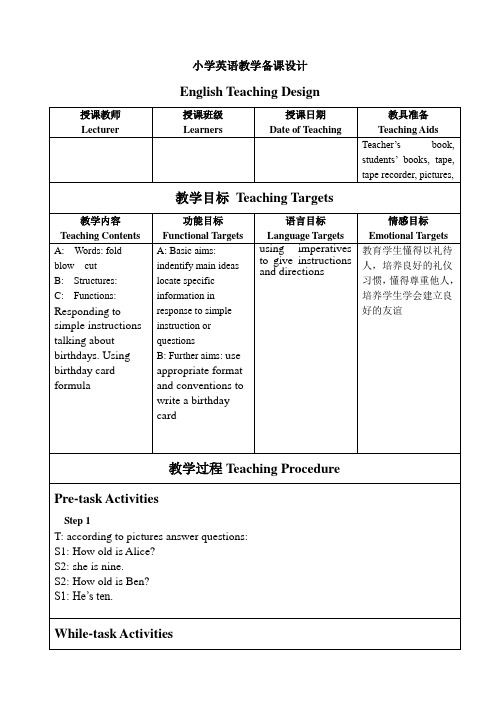
How old are you?
How old is he/she?
课后作业Assignments
课后反思Reconsideration
A:copy the new words
B:read the text
S1: How old isAlice?
S2: she is nine.
S2: How old is Ben?
S1: He’s ten.
While-task Activities
Step 1
T: Look at these cards listen to the recording of the text, then in order to put them.
教学目标Teaching Targets
教学内容
Teaching Contents
功能目标
Functional Targets
语言目标
Language Targets
情感目标
Emotional Targets
A: Words: fold blow cut
B: Structures:
C: Functions:Responding to simple instructions talking about birthdays. Using birthday card formula
using imperatives to give instructions and directions
教育学生懂得以礼待人,培养良好的礼仪习惯,懂得尊重他人,培养学生学会建立良好的友谊
教学过程Teaching Procedure
Pre-task Activities
(沪教版)牛津英语4A教案Module1Unit2period3

Module 1 Getting to know youUnit 2 How old are you?The third periodKnowledge objective:1. Learn the words and phrases: ride, ride a bicycle/ horse2. Learn the expressions: Ride your bicycle in the playground, please.3. Ask and answer:- Is this your pencil, Kitty?- No, it isn’t my pencil./Yes, it’s my pencil.- Is this his / her …?- Yes, it’s his / her …. (No, ….)Skill objective:1. Ask and answer the questions.2. Be able to act out the dialogue.Emotion objective:Educate the students to obey the rules in their daily life.I. Pre-task preparation1. Chant: When’s your birthday?2. Answer: What do you do at the birthday party?3. Match the sentences:How old are you, Ted? ( ) Thank you.Here’ s your present. ( ) I’m fine, thanks. Today is my birthday. ( ) He’s seven.How are you? ( ) Happy birthday to you! Can you make a birthday card? ( ) I am eleven.How old is your brother? ( ) Yes, I can.II. While-task procedure(一) Text:1. Read and judge:( ) 1. The boy’s name is Ben Li.( ) 2. Ben is ten.( ) 3. This is Ben’s bicycle.( ) 4. He is riding a horse now.( ) 5. The policeman suggests Ben to ride the bicycle in the playground.2. Learn the phrases: ride a bicycle/ bike; ride a horse3. Read the text after the tape4. Read the text together5. Act out the text6. T: If you’re the policeman, what would you say to Ben?(Ride y our bicycle in the park/ …OR: Don’t ride the bicycle. Because you’re too young.)(二) Sentence patterns:1. Read and practice:-- Is this your pencil, Kitty?-- Yes, it’s my pencil. (No, it isn’t my pencil.)(bicycle / Eddie; milk / Wendy; card / Ginger)2. Read and practice:-- Is this his rubber?-- No, it isn’t his rubber.-- Is this her rubber,?-- Yes, it’s her rubber.(desk yo yo telephone toy dog skateboard)III. Post-task activity1. Aaswer the question:1) Is this your car? (yes)2) Is that his ball? (no)3) Is this her blouse? (yes)4) Is this Tom’s parrot? (yes)5) Is that your sister’s bag? (no)2. Read and complete the dialogue:-- Excuse me!-- Yes?-- Is this your schoolbag?-- No, it isn’t. It’s Tom’s schoolbag. Tom’s schoolbag is black. -- Tom! Is this your schoolbag?-- Yes, it is.-- Here you are.-- Thank you.3. Act out the dialogue in the groups of three.IV. Homework1. Listen and read on Page 7.2. Copy the words and the text.3. Act out the dialogue.。
牛津上海版4AM4U1教案
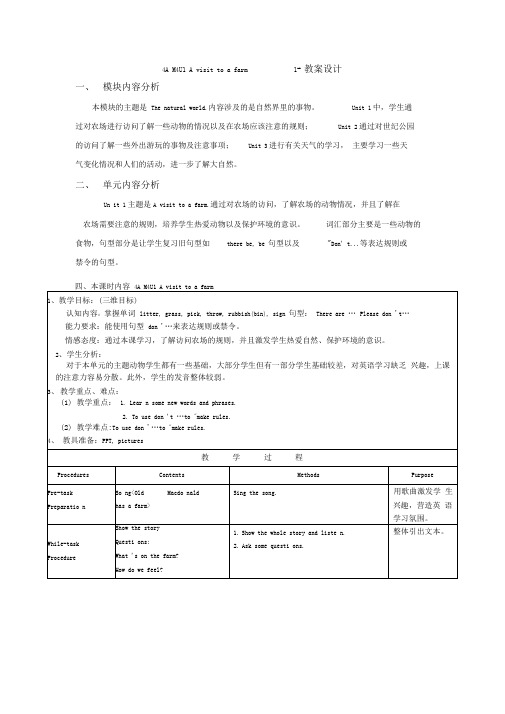
4A M4U1 A visit to a farm 1st教案设计
一、模块内容分析
本模块的主题是The natural world.内容涉及的是自然界里的事物。
Unit 1中,学生通过对农场进行访问了解一些动物的情况以及在农场应该注意的规则;Unit 2通过对世纪公园的访问了解一些外出游玩的事物及注意事项;Unit 3进行有关天气的学习,主要学习一些天
气变化情况和人们的活动,进一步了解大自然。
二、单元内容分析
Un it 1主题是A visit to a farm.通过对农场的访问,了解农场的动物情况,并且了解在
农场需要注意的规则,培养学生热爱动物以及保护环境的意识。
词汇部分主要是一些动物的食物,句型部分是让学生复习旧句型如there be, be 句型以及"Don' t...等表达规则或
禁令的句型。
4A M4U1 A visit to a farm。
(沪教版)牛津英语4A教案Module1Unit2period2

Module 1 Getting to know youUnit 2 How old are you?The second period Knowledge objective:1. Learn the words: cut, to, dear, blow2. Learn the expressions: Here’s your ….Skill objective:1. Be able to know what the children do at the birthday party.2. Be able to make a birthday card.Emotion objective:Educate the students to be polite with others.I. Pre-task preparation1. Sing a song:”If you are happy”2. Quick response1). How are you?2). How old are you?3). How old is your … ?4). What’s your/ his/ her name?5). Can you read that book to me?6). Can you make a birthday card?3. Speaking (检查回家作业)4. Fill in the blanks:-- Excuse ______. -- Yes?-- What’s _______ name? -- _____ name is Linda.-- _____ _____ are you? -- I’m ________.-- Thank you. -- ______ at all.II. While-task procedure(一) Words:1. Listen and spellsnow show slow blownear fear tear dear2. Explain and practice:dear: dear Mum/ mother; dear Dad/ mather dear Kitty; dear children blow: blow the candle The wind blows and blows.cut: cut the cake; cut the paper; cut the grass; cut the apple(二) Sentence pattern:1. Read the sentences: -- Here’s your cake.-- Thank you.2. Substitution drills:sweet paint ruler dress coat umbrella(三) Text:1. Listen to the text and answer: Whose birthday is today?(Sing the song with the tape.)2. Read the text.3. T: What do you do at the birthday party?Discuss and learn to say:make a wish; blow out candles; sing a birthday song; eat birthday cakel;sing a birthday song; play computer games; open presents4. Let’s chant (Cambrige English):Birthday, birthday, when’s your birthday?Not today, not today, my birthda y isn’t today.Whose birthday is it today?It’s Sam’s birthday. It’s Sam’s birthday.Birthday, birthday, when’s your birthday?It’s today. It’s today. Today’s my birthday.Happy birthday! Happy birthday!Thank you very much. Let’s eat the birthday cake.Le t’s eat the birthday cake.(四) Make a birthday card:1. Fold the card.2. Draw a picture on the card.3. Write: Dear AliceHappy Birthday!From KittyIII. Post-task activity1. Listen and fill in the blanks:Today’s Peter’s birthday. He’s in the garden with his parents. They’re having a birthday party. Bill and Tom are there, too. Now they’re eating the cake. Peter is opening his present. He is very happy.2. Read the passage.IV. Homework1. Read the text.2. Copy the words and text.3. Make a birthday card.。
(完整word版)上海版牛津英语4A教案

Module 1 Getting to know youUnit 1 Hello againPeriod OneTeaching contents: Look and say & Look and talkTeaching aims :1. Basic aims :a. Using nouns to identify people. e.g. Kitty ’smy classmate.b. Using demonstratives to refer to people. e.g. This is myc. Using possessive adjectives. e.g. This is our dog.2.Developing aims:ing possessive adjectives to show possession.ing formulaic expressions to greet people and respond to greetings,introduce others and take leave.c.Free talk.cation aims: Greet people and introduce oneself politely.Difficult and key points:1.Introducing someone to someone else.2.Possessive adjectives.Teaching aids: pictures, word cards, cassette player, and soft toy animals Teaching Procedure:教课步骤方法与手段增补与改正Warming-up 1.Rhyme(Two fat boys in the rain)2.Song (Good morning)Pre-taskpreparation1.Revision ing two soft toy animals to review thegreetings and response.Cat: Good morning.How are you?Dog: I ’m fine, thanks.2. Move round the class and greetindividual students using‘Goodmorning. How are you?’3. Ask students to greet each other inpairs.2.Presentation 1. Use glove puppets to identify people.Introduce: Ben, Kitty, Eddie,andWendy.2. Guess: Who is Wendy?to elicit: She ’sEddie ’ssister.While-taskprocedure1.Introduce: 1. Invite one student to stand up. Say:classmate He/She is your classmate. You ’reclassmates.2. Imitation(Show the word card) Ask students toread the word several times.3. Invite a different student to stand up.Ask: What ’shis/her name? Prompt thestudents to say: This is my classmate.His/Her name ’s ___.4. Substitution:In groups of four, have studentsintroduce their classmates.2.Introduce:our 1. Show the toy dog. Ask: Whose dog isthis? to elicit: It ’sKitty and Ben ’sdog.2. Play the cassette: This is our dog. Hisname ’sSam.3. Imitation:a. Show the word card. Ask students toread the word.b. Play the cassette again. Thestudents listen and repeat.4. Sentence making: e.g. This is ourfriend/classmate/teacher. His/Hername ’s___.3. Listen and 1. Play the cassette: Look and say. The answer students listen carefully.2.Answer the questions:Who ’sEddie ’sclassmate?Who ’sWendy?Whose cat is this?What ’sthe cat ’sname?3.Play the cassette again.The students listen and repeat.Post-taskactivities1. Production1. In groups of four, have the studentspractice the dialogue.2. Play a game (Look and talk)a. Write the numbers on the back ofthe word card.b. Students choose the differentnumbers.c. Then ask students to complete thedialogue according to their cards.3. Free talkEncourage students to introduce theirpets, their classmates using their ownname and their toy animals.2. Assignment 1. Introduce your parents using ‘This isHis/Her name ’s2.Write about one of your classmates.成功经验课板后书随设思虑与对策笔计Period TwoTeaching contents: Read a story & Learn the soundTeaching Aims:1.Basic aims:ing verbs to describe actions. e.g. run, swim, jumping modals to talk about ability. e.g. She can run.c. Using connectives to link contrasting ideas e.g. But she can’tcook.d.Saying the sound ‘ch- ‘2.Developing aims:a.Read and act the storyb.Talking about ability.c. Write a simple story.Teaching aids: pictures, word cards, cassette player, and mask Teaching Procedure:教课步骤方法与手段增补与改正Warming-up Song (I can sing)Pre-taskpreparation1. Revision 1. Say and act: sing, draw, write2. Sentence making:e.g. I can draw a dog.I can sing a song.2. Presentation 1. Put on the mask. Ask: Do youknow him? to elicit: He is aSuperman.2. Encourage students to describeSuperman.e.g. He’s strong. He’sbrave/super.While-taskprocedure1.Introduce: 1. Ask students to guess whatrun, jump, Superman can do.swim, dive, 2. Put the word and picture cards onfly the board in random order. Usingmine, introduce: run, swim, jump,dive, and fly.3. Read the words with actions.4. Invite individual students to comeout and match the words andpictures.5. Invite students to say whatSuperman can do.e.g. He can run. He can dive.2.Introduce: 1. Ask students what they thinkcook, Superman can ’tdo.2. Using mime, introduce: cook3. Introduce: Superman can fly. Buthe can ’tcook.4.Sentence making:e.g. I can sing. But I can’tfly.3.Read the 1.Ask: Do you like Superman?story to elicit: Alice likes Supergirl.She ’s reading a story aboutSupergirl.2.Ask students what they thinkSupergirl can or cannot do.3.Play the cassette. The studentslisten and check their guesses.4.Play the cassette again. Thestudents listen and repeat.Post-taskactivities1. Production 1.True or FalseAsk students to read thestatements in Read and answer.Do number 1 and number 2 withthe students to help themunderstand the words ‘True’and‘False’.Then ask them to finishthe rest of the exercise.2. Invite students to retell the story.3. Draw and writeDivide students into groups offour. Have them draw a picture oftheir favourite cartoon characterand write the caption underneath.Then talk about each drawing.2. Learn the 1. Have students repeat the soundsound and words after you.2. Play the cassette. Students listenand repeat.3.Invite individual students to readaloud the sentences.3. Assignment 1. Retell the story.2. Write a story about your favouritecartoon character.课成功与经验板后书随思虑与对策设笔计Period ThreeTeaching contents: Look and say & Ask and answerTeaching aims:1.Basic aims:a. Using verbs to describe actions. e.g. paint, readb. Using interrogatives to ask‘yes/no’-questions to obtain simple responses.e.g. Can you swim?c. Using modals to talk about ability.e.g. Yes, I can. / No, I can ’t.2 .Developing aims:a. Asking about ability.b. Do a survey in class.cation aims: Talking about ability to establish friendly relations withyour classmates.Teaching aids: pictures, word cards, cassette player,Teaching Procedure:教课步骤方法与手段增补与改正Warming-up 1. Song2. Responding to simpleinstructionse.g. Sing a song. Draw a circle.Pre-taskpreparation1. Revision Invite individual students to cometo the board and choose a PictureCard and mime whether they cando or can ’tdo a particular action.The rest of the class say: He/Shecan/can ’t2.Presentation Invite individual students to stand up.Point to the pictures and ask: Canyou ? And prompt them to use: Yes, Ican. /No, I can ’t. to answer yourquestions.While-taskprocedure1. Introduce: 1. Introduce: paint by miming apaint painting action, and then stickthe Word and Picture Cards onthe board.2. Read the word with action.3. Ask individual students: Canyou paint? to elicit: Yes, Ican./No, I can ’t,4. Ask and answer in pairs.2.Introduce: 1. Draw a picture on the board.read Ask: What can she do? to elicit:She can read.2.Read the word in different voices.3.Ask individual students: Can youread? What can you read? toelicit: I can read English/a story.3.Listen and 1. Play the cassette: Look andsay say. Students listen.2. Play the cassette again.Thestudents follow in their booksand, in groups of four,practicethe dialogue.3.Invite individuals to read thedialogue to the class.Post-taskactivities1.Production 1. Show a photo album.Tellstudents that it is your album.Encourage them to ask aboutyour photograph using‘Canyou ?’2.Students work in pairs using thepictures in Ask and answer to findout what their partner can andcannot do.3.Do a survey:Ask students to walk around theclass and interview three to fiveclassmates. Students are to findtheir classmates who can orcannot do a certain thing.Invite individual students toreport back to the class.2.Assignment plete Workbook page two.2. Write about your ability using ‘Ican ’课成功与经验板后书随思虑与对策设笔计Module 1 Getting to know youUnit 2How old are you?Period OneTeaching contents:Look and say.Ask and answerTeaching aims:1. Basic aim:能听懂,会说,会读本课对话. E.g. How old Happy?birthday. Thank you.2. Education aim:会互相咨询对方年纪,庆祝对方诞辰,增进感情。
上海版牛津英语4A课程教案

Module 1 Getting to know youUnit 1 Hello againPeriod OneTeaching contents: Look and say & Look and talkTeaching aims :1. Basic aims :a. Using nouns to identify people. e.g. Kitty’s my classmate.ing demonstratives to refer to people. e.g. This is my …ing possessive adjectives. e.g. This is our dog.2. Developing aims:ing possessive adjectives to show possession.ing formulaic expressions to greet people and respond togreetings, introduce others and take leave.c.Free talk.cation aims: Greet people and introduce oneself politely. Difficult and key points:1. Introducing someone to someone else.2.Possessive adjectives.Teaching aids: pictures, word cards, cassette player, and soft toy animalsPeriod TwoTeaching contents: Read a story & Learn the soundTeaching Aims:1.Basic aims:ing verbs to describe actions. e.g. run, swim, jumping modals to talk about ability. e.g. She can run.ing connectives to link contrasting ideas e.g. But she can’tcook.d.Saying the sound ‘ch-‘2. Developing aims:a. Read and act the storyb. Talking about ability.c. Write a simple story.Teaching aids: pictures, word cards, cassette player, and maskPeriod ThreeTeaching contents: Look and say & Ask and answerTeaching aims:1.Basic aims:a. Using verbs to describe actions. e.g. paint, readb. Using interrogatives to ask ‘yes/no’-questions to obtain simpleresponses. e.g. Can you swim?c. Using modals to talk about ability.e.g. Yes, I can. / No, I can’t.2 .Developing aims:a. Asking about ability.b. Do a survey in class.cation aims: Talking about ability to establish friendly relations withyour classmates.Teaching aids: pictures, word cards, cassette player,Module 1 Getting to know youUnit 2 How old are you?Period OneTeaching contents: Look and say. Ask and answer Teaching aims:1.Basic aim: 能听懂,会说,会读本课对话. E.g. How old …? Happybirthday. Thank you.2.Education aim: 会相互询问对方年龄,庆贺对方生日,增进感情。
(整理)上海版牛津小学英语4A四年级上册教案全册.
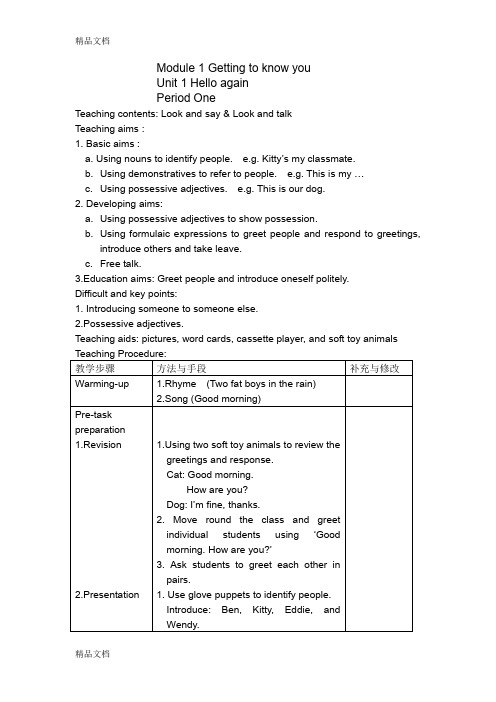
Module 1 Getting to know youUnit 1 Hello againPeriod OneTeaching contents: Look and say & Look and talkTeaching aims :1. Basic aims :a. Using nouns to identify people. e.g. Kitty’s my classmate.b. Using demonstratives to refer to people. e.g. This is my …c. Using possessive adjectives. e.g. This is our dog.2. Developing aims:a. Using possessive adjectives to show possession.b. Using formulaic expressions to greet people and respond to greetings,introduce others and take leave.c. Free talk.cation aims: Greet people and introduce oneself politely.Difficult and key points:1. Introducing someone to someone else.2.Possessive adjectives.Teaching aids: pictures, word cards, cassette player, and soft toy animalsPeriod TwoTeaching contents: Read a story & Learn the soundTeaching Aims:1. Basic aims:a. Using verbs to describe actions. e.g. run, swim, jumpb. Using modals to talk about ability. e.g. She can run.c. Using connectives to link contrasting ideas e.g. But she can’t cook.d. Saying the sound ‘ch-‘2. Developing aims:a. Read and act the storyb. Talking about ability.c. Write a simple story.Teaching aids: pictures, word cards, cassette player, and maskPeriod ThreeTeaching contents: Look and say & Ask and answerTeaching aims:1.Basic aims:a. Using verbs to describe actions. e.g. paint, readb. Using interrogatives to ask ‘yes/no’ -questions to obtain simple responses.e.g. Can you swim?c. Using modals to talk about ability.e.g. Yes, I can. / No, I can’t.2 .Developing aims:a. Asking about ability.b. Do a survey in class.cation aims: Talking about ability to establish friendly relations with yourclassmates.Teaching aids: pictures, word cards, cassette player,Module 1 Getting to know you Unit 2 How old are you?Period OneTeaching contents: Look and say. Ask and answerTeaching aims:1.Basic aim: 能听懂,会说,会读本课对话. E.g. How old …? Happybirthday. Thank you.2.Education aim: 会相互询问对方年龄,庆贺对方生日,增进感情。
上海牛津英语 4AM4U3 teaching plan 公开课教案 区级获奖 单元教案

Oxford English 4A M4U3 Weather School:Teacher:一、教材内容:二、单元教学目标:【语用任务】在Jill介绍自己家乡上海一年中各个月份的不同天气的情境中,能够对不同月份的天气进行提问并且做出回答;在Jill与来自澳大利亚、英国、新加坡的朋友通信的情境中,能够对比不同国家的不同天气,并且能够撰写电子邮件介绍自己国家的天气;在Jill课堂学习的情境中,关注到不同季节的不同气候,并且对自己喜欢的季节做出较完整的描述。
内容完整,表达流利,拼写及语法基本正确。
●语言知识与技能1、能够正确认读、理解和运用核心词汇sunny, rainy, windy, warm, hot, wet, January, February, March, April, May, June, July, August, September, October, November, December, China, Australia, always,做到音、形、义的统一;能关注到不同季节、不同月份的不同天气。
2、能够运用特殊疑问句How’s the we ather in …?来询问不同季节、地区的天气情况,并能够根据实际情况做出相应的回答:It’s ...3、能够运用已学过的句型What are they?和Do you like...? 等句型询问他人对季节、月份的了解状况。
4、能够听辨字母组合“th- ”在单词thin, think, path等词汇中的正确发音。
●语言情感通过学习了解不同国家、不同季节和不同月份的不同天气,培养学生观察生活的能力,通过与来自不同国家朋友的对话和电子邮件中,了解不同国家的不同天气,提高文化意识,激发学生热爱生活的感情。
●学习策略通过学生欣赏、对话、读诗、小组活动、写电子邮件等多种形式,完成语段输出,达到语言运用的目的。
四、单课教学目标4AM4U3 WeatherDifferent countries, different weather (Period 2)一、第二课时文本主体文本I’m Jill. I live in China. It’s December now. It’s cold and cloudy in Shanghai. We can go to the gym. It’s sunny and hot in May and June. We can go to the beach and go swimming. And in March, it’s often warm. We can ride a bicycle. In September and October, it’s windy and cool. We can fly a kite.I have a friend, Amy. She is from Australia.Jill: Hello! This is Jill.Amy: Hello, Jill! This is Amy. How’s the weather in China?Jill: It’s cold and cloudy. How’s the weather in Australia now?Amy: It’s sunny and hot. We can go to the beach.Jill: How’s the weather in May and June then?Amy: It’s cool and windy. In May and June, it’s always cool here. We can fly a kite.Tony: Hello! This is Tony.Jill: Hello, Tony! This is Jill.Tony: I’m your new friend in the UK. My hometown is very nice. It always snows in December. We can make a snowman. How’s the weather in China now?Jill: It’s cold and windy. We can fly a kite.Tony: Wow! It’s fun!Jill: Thanks for calling. See you!Tony: See you!An e-mail from Emma.To: JillSubject: The weather in SingaporeHi, Jill.I’m Emma. I live in Singapore. It’s December now. It’s warm and rainy in Singapore. We can go to the park. In May and June, it’s sunny and hot. We can go to the beach and make sandcastles there. In September, it’s cool. It’s beautiful.How’s the weather in China? Please write and tell me about it. Your friend,Emma预设输出语言:The weather in ______________ is very beautiful.It’s ______ (month) now.It’s _____ and _____.We can __________.Sometimes it’s _______.We can _________.How _______!二、第二课时教学过程三、第二课时课堂练习设计。
上海教育出版社牛津英语4A教学说课(Unit1)

教学方 法和手
段 (打印 或手写 补充)
Rhymeplaythecassette. Askandanswer,Groupwork.
课时教学互动流程
补充
教师行为
学生行为
课堂变化及 处理主要环
节的效果
教学目标的 达成落实
Ⅰ、Warming-up Song:《Goodmorning》 Ⅱ、Presentation 1.Moveroundtheclassand
达标反馈:
课后基础性作业 Listentothetape. Readthetext.
课后拓展性作业 Introduceyourfriend
UsingThisis…
His/Hername’s…
教学后记(必须手写)
课时教学设计首页
课题
Module1Unit1Meetingnewpeople
课型
New
第几 课时
课时教学互动流程
补充
教师行为
学生行为
课堂变化及 处理主要环
节的效果
教学目标的 达成落实
Ⅰ、Warming-up 1.Listentothesay. 2.Showpuppettoimamate sentence:
Thisis… Ⅱ、Presentation
Thisismydog. Hisname’sSam. e.g.Thisismysister /brother. Her/Hisname’s .
AskSstoreadthewordseveraltimes.
3.Listenandanswer
3.Inviteadifferent
Playthecassetteegaing.
studenttostandup.
牛津英语沪教版4AM1U1教案

4AM1U1 Meeting new people 单元设计一、单元任务分析该单元的主题为meeting new people,要求学生掌握的核心词汇是数词:eleven, twelve, thirteen, fourteen, fifteen, sixteen,可根据不同学校的具体情况拓展至hundred。
主要句型是His\Her name is…而his\her 的用法也是本单元的重点。
能从外表、能力等方面描述自己的朋友,班级里的新同学,并通过介绍朋友、新同学掌握his\her的用法。
除了核心词之外,本单元的新词汇和新词组难度比较大,包括student number, live near, walk to school,be going to这些单词和词组虽然不是核心词汇,但是在做介绍以及日常交流中实际使用价值较大,可结合学生的实际情况进行教学,使学生可以做到运用这些词汇进行简单交流。
对自己的朋友和新同学的介绍是本单元的重点。
学生已经可以用简单句型进行介绍,比如He\She is...He\She can...在这样的基础上引导学生更加全面有顺序的进行介绍,从姓名、外表、能力、爱好等方面入手,使语段更加丰满。
并能正确使用物主代词his\her来描述姓名、外貌、学号等。
可以引导学生珍惜身边的好朋友,善待新同学并学会相互尊重和欣赏。
二、单元整体设计,目标统整M1U1 Meeting new people【第一课时教学设计】Meeting new people at the EXPO一、教学目标1. Words: eleven, twelve, thirteen, fourteen, fifteen, sixteen...2. Structure: His\Her name is...His\Her student number is ...二、教学重点与难点1. The usage of nouns to identify people.2. Using possessive pronouns to introduce one’s name and gesture.三、教育技术与学习资源应用PPT、黑板、故事卡片、视频支持四、本课时文本内容Nice to meet you too. Welcome to Shanghai. My Name’s _____. I’m …五、教学过程【第二课时教学设计】 A new classmate一、教学目标1. New words:live, near, walk, Sally, Paul, Jill, Poe and Rose2. Phrases: be going to, walk to, play well, every day3. Using the modeled sentences to ask and answerWhat about you, ___? I’m ___.4. Using modeled sentences to make a new dialogue about different persons5. Using formulaic expressions to describe their friends6. Helping the students introduce their friends, classmates or parents.二、教学重点与难点1. Reading and spelling the words and phrases correctly.2. Using wh-questions to find out different information.3. Using modeled sentences to ask and answer about fancy.4. Saying and using the phrases correctly and fluently5. Using modeled sentences to describe the one they like best三、教育技术与学习资源应用PPT、黑板、故事卡片、视频支持五、本课时文本内容Hello, My name is Peter. I’m ten years old. My student number is eighteen.I like playing.I can play football well. This is my sister. Her name is Sally. She’s twelve. And this is my brother. His name is Paul. He is only six. We are going to the park.五、教学过程【第三课时教学设计】About Jill一、教学目标and spell the words correctly: mask ,ask , laugh, smilethe phrases fluently: put on, welcome toa short dialogue with the sentences that the text gives.the pronunciation of “-sk” in words such as desk and mask.the modeled sentences to introduce somebody.modeled sentences to make a new dialogue about different personsformulaic expressions to describe their friends.the students introduce their friends, classmates or parents.二、教学重难点1. Use wh-questions to find out different information2. Use modeled sentences to ask and answer about fancy三、教育技术与学习资源应用PPT、黑板、故事卡片、视频支持四、本课时文本内容We have a new classmate, Jill. She’s ten years old. She lives near our school. She walks to school every likes reading, and she can play basketball well. She can dance likes dancing.五、教学过程Teaching aids: Multi-media。
牛津英语上海版4AM4U2AtCenturyPark课件

每周完成一个单元的学习,共计 10个单元。
Course format
课程形式
本课程采用线上授课形式,通过视频会议软件进行实时互动教学。
课程教材
使用《Oxford English Shanghai version 4am4u2atcenturrypark》教材,配合教师讲解和实例演示进行教 学。
课程资源
02
Course content
Unit Theme
01
Unit 1
Family and friends
02
Unit 2
School life
பைடு நூலகம்03
Unit 3
Hobbies and interests
04
Unit 4
Travel and tourism
Detailed explanation of knowledge points
Students preparing for international exams such as TOEFL, IELTS, and SAT.
English language learners who want a comprehensive course that covers all areas of English language proficiency.
互动环节
学生对于课堂互动环节的评价较 高,认为这些活动有助于提高他 们的口语表达和交流能力。
Teacher evaluation
专业素养
教师具备扎实的专业知识和丰富的教学经验,能够为学生提供优 质的教学服务。
教学态度
教师认真负责,关注学生的学习进展,能够耐心解答学生的问题, 积极引导学生思考。
上海版牛津英语4a教案全册
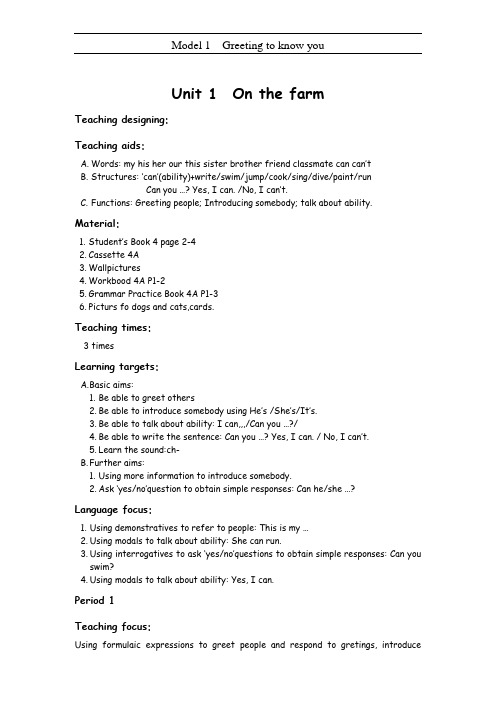
Model 1 Greeting to know youUnit 1 On the farmTeaching designing:Teaching aids:A.Words: my his her our this sister brother friend classmate can can‟tB.Structures: …can‟(ability)+write/swim/jump/cook/sing/dive/paint/runCan you …? Yes, I can. /No, I can‟t.C.Functions: Greeting people; Introducing somebody; talk about ability. Material:1.Student‟s Book 4 page 2-42.Cassette 4A3.Wallpictures4.Workbood 4A P1-25.Grammar Practice Book 4A P1-36.Picturs fo dogs and cats,cards.Teaching times:3 timesLearning targets:A.B asic aims:1.Be able to greet others2.Be able to introduce somebody using He‟s /She‟s/It‟s.3.Be able to talk about ability: I can,,,/Can you …?/4.Be able to write the sentence: Can you …? Yes, I can. / No, I can‟t.5.Learn the sound:ch-B.Further aims:ing more information to introduce somebody.2.Ask …yes/no‟question to obtain simple responses: Can he/she …? Language focus:ing demonstratives to refer to people: This is my …ing modals to talk about ability: She can run.ing interrogatives to ask …yes/no‟questions to obtain simple responses: Can youswim?ing modals to talk about ability: Yes, I can.Period 1Teaching focus:Using formulaic expressions to greet people and respond to gretings, introduceothers and take leave.Using demonstratives to refer to people. Using nouns to identify people. Teaching steps:Period 2Teaching focus:Using modals to talk about ability Using verbs to describe actionsUsing connectives to link contrasting ideas Teaching steps:Period 3Teaching focus:Using modals to talk about abilityUsing interrogative s to ask …yes/no‟ questions to obtain simple responses Teaching steps:Unit 2 How old are you? Teaching design:This unit tell the students how to ask the ages. So, at first I‟d like to let the students to know when they need to know the ages and why they want to know. Teaching aids:D.Words: old, happy birthday, blow, cake, rideE.Structures: How old are you? I‟m…F.Is this your…? Yes, it‟s…/No, it isn‟t…G.Functions: Asking questions to find out the ageMaterial:7.Student‟s Book 4A page 5-78.Cassette 4A and a cassette player9.Photograph page 3-710.WorkbookTeaching times:3 timesLearning targets:C.Basic aims:Asking ‟How‟ questions to find out your ageing interrogatives to elicit ‟yes/no‟ responseE.Further aims:Asking questions to find out the ageing imperatives to give instructions and directions Language focus:ing nouns to identify thingsing daily expressions to express good wishesing imperatives to give instructions and directionsing possessive adjectives to show possession Period 1Teaching focus:Using nouns to identify thingsAsking questions to find out the ageUsing daily expressions to express good wishes Teaching steps:Period 2Teaching focus:Writing:Use appropriate format and conventions to write a birthday card Listening:A Identify main ideas (listening task)B Locate specific information in response to simpleC Instructions or questions (listening task)Teaching steps:Period 3Teaching focus:Speaking:Maintain an interaction by using formulaic phrases to acknowledge, agree and disagree, ask questions and replyListening:Identify key words in an utterance by recognizing the stressTeaching steps:Unit 3 What are you?Teaching designing:Teaching aids:H.Words: teacher doctor dentist nurse shop assistant waiter waitress cookbus-driver policeman fireman postmanStructures: What‟s he/she? What does your father/mother do?He‟s/She‟s a(an)…Are you …? Yes, I‟m …/No, I‟m not …I.Functions: …Wh-‟questions to find out a person‟s identity;As king simple questionsto obtain …yes/no‟reponsesMaterial:11.Student‟s Book 4 page 8-1212.Cassette 4A13.Wallpictures14.Pictures for occupation15.Teaching times:3 timesLearning targets:F.Basic aims:ing nouns to identify people, and events.7.Asking …Wh-‟questions to find out a person‟s identity.8.Asking simple questions to obtain …yes-no‟responses.G.F urther aims:3.Know more words for occupation.4.Try to describe one job‟s character.Language focus:10.U sing nouns to identify people,and events: She‟s a policewoman.11.Ask ing …Wh-‟questions to find out a person‟s identity: What‟s she?12.A sking simple questions to obtain …yes-no‟responses: Are you a fireman?13.U sing noun phrases to identify people: yes, I‟m a fireman.Period 1Teaching focus:Using nouns to identify people, and events. Asking‟Wh-‟questions to find out a person‟s identity Teaching steps:Period 2Teaching focus:Using nouns to identify people, animals and objects Asking‟Wh-‟questions to find out a person‟s identity Teaching steps:Period 3Teaching focus:Asking‟Wh-‟questions to find out various kinds of specific informantion about a person.Using nouns to identify people.Teaching steps:Period 4Teaching focus:Using noun phrases to identify peopleAsking simple questions to obtain ‟yes/no‟responses Teaching steps:Period 5Teaching focus:Using formulaic expression to greet people Using …Wh-‟que stions to find out a specific thing Asking‟How‟questions to find out a person‟s age Asking‟Wh-‟questiongs to find out a person‟s job Asking‟yes/no‟questions to obtain simple responses Teaching steps:BOOK4A UNIT2PERIOD1DATE/ / Teaching aims:Speaking:1.U se modelled phrases and sentences to communicate with other learns2.U se appropriate intonation in questions and statementsListening:1.Locate specific information in response to simple questions2.Identify key words by recognizing the stress3.Recognize language patterns previously encountered in new spoken textsWritingDevelop written texts by putting words in a logical orderBOOK4A UNIT2PERIOD2DATE/ / Teaching aims:Listening: 1. I dentify key words by recognizing the stress 2. R ecognize differences in the use of intonation to differentiate between questions and statements Speaking:1. Use modelled words and phrases to communicate with other learners2. Ue appropriate intonation in questions and statements3. Open an interaciton by eliciting a response4. Maintain an interaction by providing information to factual questions Reading: 1. P redict the meaning of unfamiliar words by using context or picture cues 2. L ocate specific information in a short text in response to questions Writing:Use the basic conventions of written English to combine letters to form wordsBOOK 4A UNIT2 PERIOD3 DATE / / Teaching aims:Listening: 1. D iscriminate between words with different initial sounds Speaking: 1. P ronounce correctly words with initial diagraphs cr- and br- in an utterance Reading:1.Recognize familiar words in unfamiliar contextsBOOK 4A UNIT 3 PERIOD 1 DATE / / Teaching aims:Listening: 3. R ecognize differences in the use of intonation between questions and statements and respond appropriately 4. I dentify key words by recognizing the stress 5. L ocate specific information in response to simple questions Speaking:1. Open an interaction by eliciting a response2. Maintain an interaction by providing information in response to factual questions Writing:1. Gather and share information, ideas and language2. Develop written texts by putting words ina logical order to make meaningful phrases and sentencesBOOK 4A UNIT 3 PERIOD 2 DATE / / Teaching aims:Listening: 1. I dentify key words in an utterance by recognizing stress e.g. 2. R ecognize language patterns previously encountered in new spoken texts Speaking:1. Use modelled words and phrases to communicate with other learners2. Use appropriate intonation in questions and statements3. Open an interaction by eliciting a response4. Maintain an interaction by providing information in response to factual questions Reading:1.Predict the meaning of unfamiliar words by using picture cuesBOOK4A UNIT3PERIOD3DATE/ / Teaching aims:Listening:3.D iscriminate between words with different initial soundsSpeaking:1.Pronounce correctly words with initial digraphs gr-, fr and tr- in an utteranceWriting:1. Reproduce sentences from printBOOK 4A UNIT 3 PERIOD 4 DATE / / Teaching aims:Listening: 1. L ocate specific information in response to simple instructions 2. I dentify key words by recognizing the stress 3. R ecognize language patterns previously encountered in new spoken texts Reading:Predict the meaning of unfamiliar words by using the picture cuesBOOK4A UNIT3PERIOD5DATE/ / Teaching aims:Listening:1.L ocate specific information in response to simple instructions or questions2.I dentify key words in a structure by recognizing the stressSpeaking1.Open an interaction by asking questions and eliciting a responseUnit 2 More insects and plants Teaching designing:Teaching aids:Listening:3.R ecognize rhyming words.4.L ocate specific information in response to simple questions5.R ecognize and discriminate words with different initial’s’blends ‘sm-’sp-’’’st-’Speaking1.Produce simple phrases and sentences involving repetition or listse modeled phrases and sentences to communicate with teachers or other learners.3.Pronounce correctly words with different initial’s’blends in an utteranceWriting:1.Develop written texts by adding personal ideas and information to writing when a model or framework is providedMaterial:16.Student‟s Book 4 page 39-4117.Cassette 4A18.Wallpictures19.Workbood 4A20.G rammar Practice Book 4A21.Picturs for plantsTeaching times:3 timesLearning targets:H.Basic aims:9.learners sing a song about frogs and make a model10.Learners compare different parts of plants and trees.11.Learners in pairs play a guessing game about plants and trees.12.Learners make their new plants by using the pictures givenI.Further aims:5.Learners write short texts to describe some given plants by followingdescriptions and framework given.?Language focus:14.C ountable nouse: flies,mothes, frogs, trunk, branches, ladybirds15.“Wh-”question: What do … like? They like…16.A ttributive adjectives17.I nverted word order for a question: Is it a …?Period 1Teaching focus:Speaking:6.U se modelled phrases and sentences to communicate with other learns7.U se appropriate intonation in questions and statementsListening:4.Locate specific information in response to simple questions5.Identify key words by recognizing the stress6.Recognize language patterns previously encountered in new spoken textsWritingDevelop written texts by putting words in a logical orderTeaching steps:Period 2Teaching focus:Listening:2.D iscriminate between words with different initial soundsSpeaking:2.P ronounce correctly words with initial diagraphs cr- and br- in an utterance Reading:1.Recognize familiar words in unfamiliar contextsTeaching steps:Unit 3 A day in the park Teaching designing:Teaching aids:Listening:3.L ocate specific information in response to simple instructions or questionsReading:8.R ecognize familiar words in unfamiliar contextsWriting:1.Develop written texts by adding personal ideas and information to writing when a model or framework is providedMaterial:22.S tudent‟s Book 4 page 42-4523.C assette 4A24.W allpictures25.W orkbood 4A26.G rammar Practice Book 4A27.P icturs for toys.Teaching times:3 timesLearning targets:J.B asic aims:13.Learner act the dialogue about possessions14.Learners talk and write about possession of different objects withreference to photographs given15.Learners in groups make a spinner and play the board game in groups.K.Further aims:6.Learner play a memory game in pairs and write down the answers on the tasksheets.Language focus:18.…Wh-‟question: Whose … is it?19.I mperatives: Make/Write/Don‟t/Sp in/Have20.Questions: How many … are there? Do you like …?21.I nverted word order for questions: Can you see … ? Is there a …?Period 1Teaching focus:Listening:6.R ecognize differences in the use of intonation between questions and statements and respondappropriately7.I dentify key words by recognizing the stress8.L ocate specific information in response to simple questionsSpeaking:3.Open an interaction by eliciting a response4.Maintain an interaction by providing information in response to factual questionsWriting:3.Gather and share information, ideas and language4.Develop written texts by putting words in a logical order to make meaningful phrases andsentencesTeaching steps:Period 2Teaching focus:Listening:4.I dentify key words in an utterance by recognizing stress e.g.5.R ecognize language patterns previously encountered in new spoken texts Speaking:e modelled words and phrases to communicate with other learnerse appropriate intonation in questions and statements7.Open an interaction by eliciting a response8.Maintain an interaction by providing information in response to factual questions Reading:1.Predict the meaning of unfamiliar words by using picture cuesTeaching steps:Period 3Teaching focus:Listening:6.D iscriminate between words with different initial soundsSpeaking:2.Pronounce correctly words with initial digraphs gr-, fr and tr- in an utterance Writing:1. Reproduce sentences from printTeaching steps:Unit 1 In the schoolTeaching designing:Teaching aids:Listening:1.Locate specific information in response to simple instructions or questions.2.Recognize language patterns previously encountered in new spoken texts.3.recognize and discriminate words with different initial‟r‟blends …dr-‟and …pr-‟. Speaking:1.Open an interaction by eliciting a response2.Pron ounce correctly words with different initial‟r‟blends in an utterance Writing:1.Develop written texts by putting words in a logical order to make meaningful phrases and sentences.Material:28.S tudent‟s Book 4 page 24-2629.C assette 4A30.W allpictures31.Workbood 4A32.G rammar Practice Book 4ATeaching times:3 timesLearning targets:L.Basic aims:1.Learners practise numbers 11 to 20 by counting classroom objects.2.Learners make a set of number cards3.Learners practise numbers 11 to 20 by doing additions and subractions4.Learners talk about the number of objects and people in the playgournd inthe picture given.M.Further aims:7.Learners in pairs talk about the number of different shapes in the picturegiven.8.learners make a shape and colour book.Language focus:ing demonst ratives to refer to people: This is my …ing modals to talk about ability: She can run.ing interrogatives to ask …yes/no‟questions to obtain simple responses:Can you swim?ing modals to talk about ability: Yes, I can.Period 1Teaching focus:Listening:4.L ocate specific information in response to simple instructions or questions5.I dentify key words by recognizing the stressSpeaking:9.U se appropriate intonation in questions and statementsTeaching steps:Period 2Teaching focus:Listening:1.L ocate specific information in response to simple questions2.I dentify key words by recognizing the stress3.R ecognize differences in the use of intonation to differentiate between questions and statements4.R ecognize language patterns previously encountered in new spoken textsSpeaking:1.U se modelled words and phrases to communicate with other learners2.U se appropriate intonation in questions and statementsWriting:1.Develop written texts by putting words in a logical order to make meaningful phrases and sentencesTeaching steps:Period 3Teaching focus:Listening:1.L ocate specific information in response to simple instructions and questions2.I dentify key words by recognizing the stress3.D iscriminate between words with different initial soundsSpeaking:1.U se modelled phrases and sentences to communicate with teachers and other learners2.U se appropriate intonation in questions and statements3.O pen an interaction by eliciting a response4.P ronounce correctly words with initial digraphs dr- and pr- in an utteranceWriting:Develop written texts by: putting words in a logical order adding personal ideas and information to writingTeaching steps:Unit 2 Food Teaching designing:Teaching aids:J.Words: foodsStructures: What have you got? I‟ve got…K.Functions: Talking about indeterminate amounts of food. Material:33.S tudent‟s Book 4 page 27-2934.C assette 4A35.W allpictures36.W orkbood 4A37.G rammar Practice Book 4A P38.P icturs for foodsTeaching times:3 timesLearning targets:N.Basic aims:ing appropriate quantifiers for countable and uncountable nouns.17.Quantifiers: a packet of … a bottle of …18.Identify key words in an utterance by recognizing the stress.19.Opening an interaction by eliciting a response.O.Further aims:ingshopping formula10.Indefinite determiner:some(with uncountables)Language focus:26.imperatives: Put …/ Take …27.Learners talk about prices and sizes of different food items.28.Opening an interaction by eliciting a response.29.Pronounce corredctly words with different initaiqal blends in and utterance. Period 1Teaching focus:Listening:6.L ocate specific information in response to simple instructions or questions7.I dentify key words by recognizing the stressSpeaking:e appropriate intonation in questions and statementsTeaching steps:。
(沪教版)牛津英语4A教案Module1Unit3period2

Module 1 Getting to know youUnit 3 What are you?The Second PeriodLanguage focus:Knowledge objective:ing nouns to identify people (doctor, waiter…)2.Asking ‘Wh-‘ questions to find out a person’s identity.(What’s he/she?)3.Saying the sounds. ’ph-’ ‘wh-‘.Skill objective:Read the words correctly.Emotion objective:了解不同职业的作用,明白职业不分贵贱。
Materials:Student’s Book 4A page 9MediaTeaching procedures:I. Pre-task preparation:A. Read a rhyme.B. Ask & answersII. While-task procedureWords: doctor, dentist, nurseShow the picture of the hospital.What can you see in the hospital?Doctor, dentist, nurseRead the words.Dog—doctorDesk-dentistPurse-nurseTalk about the doctor, nurse, dentist.Doctor, doctor, a clever doctor.Nurse, nurse, clean nurses.Dentist, dentist, brave dentists.What can they do?Words: shop assistant, waiter, waitress, bus-driverYou want to buy something. Who can help you?You’re hungry. You want to eat something. Who can help you?Read the words.waiter, waitress.—actor, actressC. Getting to know the names of jobsfire+man---firemanpolice+man/woman---policeman/policewomanambulance+man---ambulance manshop+assistant---shop assistantbus+driver---bus-driverpost+man---postman(课中有不少表示职业的名词,其中一些是复合词)D. Say something about them.1). Write the following three groups of words on the board:bus-driver helps sick peoplepoliceman drives a busdentist looks after criminalsdoctor arrests peoples’ teeth2). Get the learners to make sentences with words from the three groups , for example:( Have a discussion in groups of four)A bus-driver drives a bus.Ask and answer.What is your father?...(Learn the words: worker, clerk, engineer, manager)III. Post-task activitiesQuick response.(Look at the pictures.) What’s he/she?Do a survey.Talk about your family.Learn the sounds.Ph/f/ photo, telephone, Philip, phone.Wh/w/ what , where, white, whale, whichIV. HomeworkListen and read on page 9.Copy the words and sentences.Talk about the professions with your friends.。
牛津上海版小学四年级上册4A教案全册
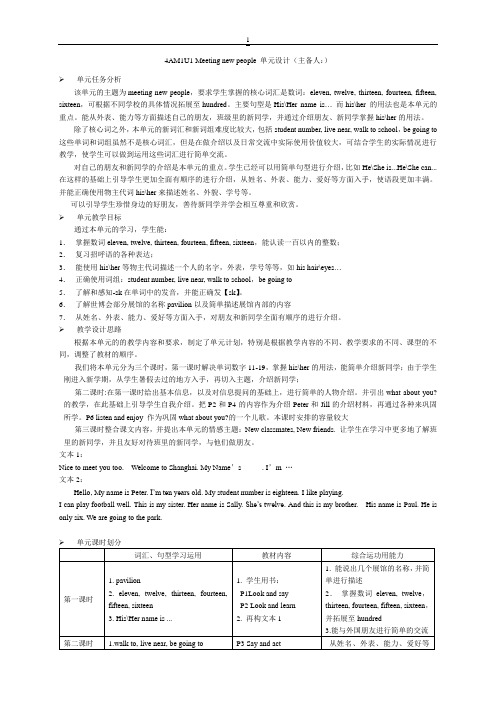
4AM1U1 Meeting new people 单元设计(主备人:)单元任务分析该单元的主题为meeting new people,要求学生掌握的核心词汇是数词:eleven, twelve, thirteen, fourteen, fifteen, sixteen,可根据不同学校的具体情况拓展至hundred。
主要句型是His\Her name is…而his\her 的用法也是本单元的重点。
能从外表、能力等方面描述自己的朋友,班级里的新同学,并通过介绍朋友、新同学掌握his\her的用法。
除了核心词之外,本单元的新词汇和新词组难度比较大,包括student number, live near, walk to school,be going to 这些单词和词组虽然不是核心词汇,但是在做介绍以及日常交流中实际使用价值较大,可结合学生的实际情况进行教学,使学生可以做到运用这些词汇进行简单交流。
对自己的朋友和新同学的介绍是本单元的重点。
学生已经可以用简单句型进行介绍,比如He\She is...He\She can...在这样的基础上引导学生更加全面有顺序的进行介绍,从姓名、外表、能力、爱好等方面入手,使语段更加丰满。
并能正确使用物主代词his\her来描述姓名、外貌、学号等。
可以引导学生珍惜身边的好朋友,善待新同学并学会相互尊重和欣赏。
单元教学目标通过本单元的学习,学生能:1.掌握数词eleven, twelve, thirteen, fourteen, fifteen, sixteen,能认读一百以内的整数;2.复习招呼语的各种表达;3.能使用his\her等物主代词描述一个人的名字,外表,学号等等,如his hair\eyes…4.正确使用词组:student number, live near, walk to school,be going to5.了解和感知-sk在单词中的发音,并能正确发【sk】。
M上海版牛津教材4A I_U3-01教案
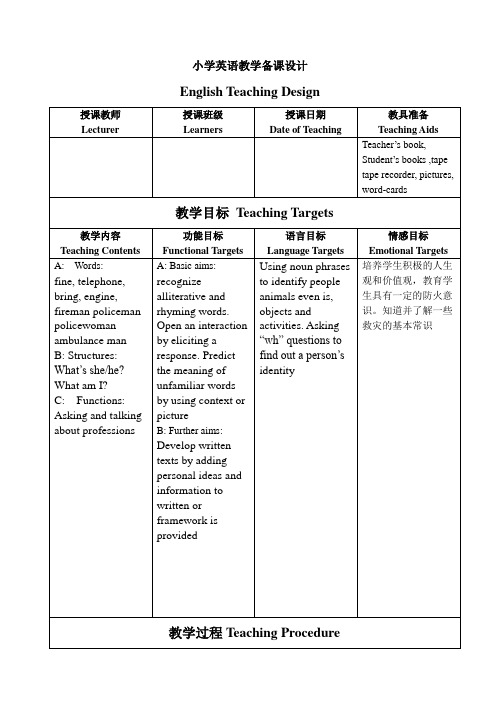
Step 1
Students stay in group. Use the word and picture cards to introduce a fireman, a policeman. Stick the cards on the board.
Step 2
word-cards
教学目标Teaching Targets
教学内容
Teaching Contents
功能目标
Functional Targets
语言目标
Language Targets
情感目标
Emotional Targets
A: Words:
fine, telephone, bring, engine, fireman policeman policewoman ambulance man
小学英语教学备课设计
English Teaching Design
授课教师
Lecturer
授课班级
Learners
授课日期
Date of Teaching
教具准备
Teaching Aids
Teacher’s book,
Student’s books ,tape
tape recorder, pictures,
Step 3
Walk around the class and pick up the appropriate pictures from your students to introduce: an ambulance, a policeman.
Step 4
Use your students pictures to introduce fireman, policeman, ambulance man policewoman. Write the words on the board. Draw one fireman on one slide of the board
上海教育出版社牛津英语4A教案Unit12
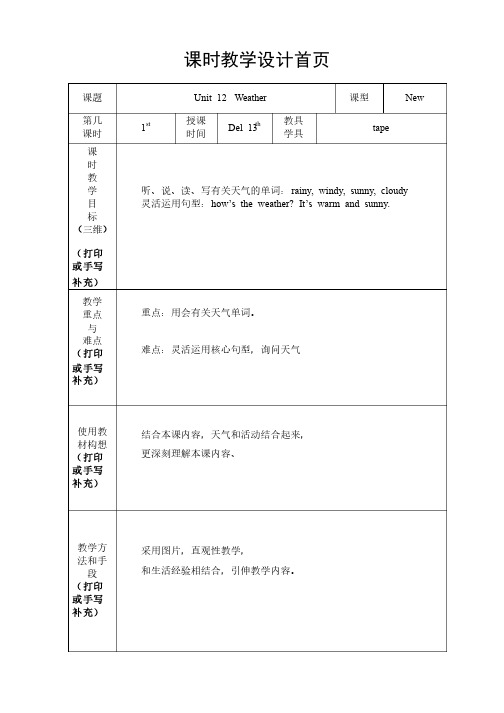
课时教学设计首页课题课题 Unit 12 Weather 课型课型New 第几第几 课时课时 1st授课授课 时间时间Del 13th教具教具学具学具tape 课 时 教 学 目 标 (三维)(三维) (打印或手写补充)听、说、读、写有关天气的单词:rainy, windy, sunny, cloudy 灵活运用句型:how how’’s the weather? It It’’s warm and sunny. 教学教学 重点重点 与 难点难点 (打印或手写补充)重点:用会有关天气单词。
重点:用会有关天气单词。
难点:灵活运用核心句型,询问天气难点:灵活运用核心句型,询问天气使用教材构想材构想 (打印或手写补充)结合本课内容,天气和活动结合起来, 更深刻理解本课内容、更深刻理解本课内容、教学方法和手段 (打印或手写补充)采用图片,直观性教学,采用图片,直观性教学,和生活经验相结合,引伸教学内容。
和生活经验相结合,引伸教学内容。
补 充教师行为教师行为学生行为学生行为课堂变化及课堂变化及处理主要环处理主要环 节的效果教学目标的教学目标的 达成落实Ⅰ、Warm-up 1.Show the pictures of seasons. T: Look at the picture. What season is it? T: How ’s the weather? Is it hot? Ⅱ、Presentation 1. words: T:(show the flashcard for cloudy ) cloudy, C-L-O-U-D-Y, cloudy. Follow the same procedure for rainy, Sunny, windy. 2. review T: (show the flashcard for sunny) Rainy: S 1: It ’s winder. S 2: No, it ’s cold S 3: Cloudy. C-L-O-U-D-Y Cloudy 补 充教师行为教师行为学生行为学生行为课堂变化及课堂变化及处理主要环处理主要环 节的效果教学目标的教学目标的 达成落实Ss (clap hands )T:(show the flashcard for rainy )Ss: Rainy 3.sentences. 1) T:(point to picture 1) How How’’s the weather? T:(point to picture 2,3)2)read follow the tape. 4. practice Game. (show the flashcard for cloudy) How How’’s the weather?…Ⅲ、Sum-up Elicit Ss to say. It It’’s rainy. It It’’s windy/sunny. Ss: 板书设计(打印或手写) 当堂学业测评或当堂达标检测当堂学业测评或当堂达标检测 ( )1. I’d like juice. A. many B. some C. any ( )2. How is the pen? A. many B. some C. much ( )3. Here are. Thank you. A. yours B. your C. you 达标反馈:达标反馈:课后基础性作业课后基础性作业1.Listen, read, say the text 2. Copy the food words. 课后拓展性作业课后拓展性作业 Wrote a shopping list. 教学后记(必须手写)☆补充设计☆☆补充设计☆课题课题 Unit 12 Weather 课型课型New 第几第几 课时课时 2nd授课授课 时间时间Del. 18th教具教具学具学具tape picture 课 时 教 学 目 标 (三维)(三维)(打印或手写补充) 通过say and act 的对话学习和表演,进一步运用核心句型,的对话学习和表演,进一步运用核心句型, 同时感受天气变化与生活的关系。
牛津小学英语4A Unit4教学案例优秀3篇

牛津小学英语4A Unit4教学案例优秀3篇牛津小学英语4A Unit4教学案例篇一教学内容:牛津小学英语4a unit4i like…第一课时教学目标:(一)认知目标:1.能听说读写单词:car,bus,bike,kite2.能听说读单词:puppet,puzzle,doll,balloon3.能听说读写句型:do you like…?以及回答yes,i do./no, i don’t..(二)能力目标:能正确掌握单词及句型进行简单的交流(三)情感目标:能激发学生的兴趣,培养其交际能力教学重点:单词的发音以及句子的理解,并能灵活运用教学难点:1.like后面加名词的复数2.各种名词变复数后的读音教学准备:1.教具准备:实物,图片,多媒体课件2.板书准备:课题unit4 i like…教学过程:step1: warming upa.greetingb.sing an english song perhapsc.free talk: what’s this in english?may i have this…?step2: presentation1.(课件,出示汽车图片)t: look at the picture,what's this in english?教授car,并且引导学生拼写2.(课件出示复数图片及句型)t: do you like cars? 引导学生回答:yes,i do./no, i don’t..引导学生发现like后面加复数,多种形式操练句型(如小组互问,同桌互问,男女生互问等)3.(出示公交车图片)t:is this a bus? s: no , it isn’t..it’s a bus.(教授bus)t: do you like buses?(重点教授buses的发音)4. (课件,出示部分图片)t: guess, what’s this? s: it’s a bike.(教授bike并操练句型,s-s,s-t)5.s: do you like bikes?t:no, i don’t. i like puzzles.(出示图片) look,what’s this in english?let’s listen to the tape.(教授puzzle)6.t: let’s do a puzzle.( 课件做拼图,洋娃娃)教授doll7.t: (课件)what’s in the doll’s hand?s: it’s a …t: a balloon.(教授balloon)8. t:(课件)look, the balloon has flew away. guess, where is it?s: perhaps it’s in the…t: perhaps it’s in the sky.(课件)look, is that a balloon?s: no , it isn’t..it’s a …t: yes , you are so clever. it’s a kite.(教授kite)9.t: next,let’s have a rest. let’s go to see a puppet show.look at this picture. do you know what’s this in english?s: it’s a …t:it’s a puppet.(教授puppet)(在新授单词和句型这一环节中,我精心设计了每一个单词的呈现方法,环环相扣,运用多种方法操练单词,如小组读,男女生读,开火车读,高低声读等,并且在每教授一个单词的过程中操练句型,做到词不离句)step3 consolidation1.game: a. what’s missing?b. do a puzzle(这两个游戏主要更进一步巩固单词,并且进行小组竞赛,激发学生的兴趣)2.t: do you like dolls?s: yes, i do.t: ok, we can buy a doll in a supermarket.shall we go to the supermarket?s: ok, let’s * *go.t: (出示实物)in the supermarket,there are a lot of thing. some toys, some fruits, some pencils and so on.3.示范对话:a: hello…!b: hello…!a: let’s go to the supermarket.b: ok!a: do you like…?b: yes, i do./no, i don’t.a: this …is for you.b: thank you.a: not at all.4.work in pairs and act the dialogue(创设场景,并且加入以前学过的水果,文具,玩具,食物类单词,整合对话,进一步体现了语言的实用性,给学生提供了体验成功的舞台)step 4 homework1.copy the new words .2.ask your father and mother what do they like.3.preview part a .教学反思:这节课我能以学生为主体,以培养学生的兴趣为情感目标,体现了语言的实用性和交际性,学生能基本掌握单词的发音,和句型的理解,教学难点也有所突破,学生能掌握like 后加名词的复数,但是由于单词教学花了过多的时间,最后的对话巩固显得有些匆忙。
- 1、下载文档前请自行甄别文档内容的完整性,平台不提供额外的编辑、内容补充、找答案等附加服务。
- 2、"仅部分预览"的文档,不可在线预览部分如存在完整性等问题,可反馈申请退款(可完整预览的文档不适用该条件!)。
- 3、如文档侵犯您的权益,请联系客服反馈,我们会尽快为您处理(人工客服工作时间:9:00-18:30)。
Module 1 Getting to know youUnit 1 Hello againPeriod OneTeaching contents: Look and say & Look and talkTeaching aims :1. Basic aims :a. Using nouns to identify people. e.g. Kitty’s my classmate.b. Using demonstratives to refer to people. e.g. This is my …c. Using possessive adjectives. e.g. This is our dog.2. Developing aims:a. Using possessive adjectives to show possession.b. Using formulaic expressions to greet people and respond to greetings,introduce others and take leave.c. Free talk.cation aims: Greet people and introduce oneself politely.Difficult and key points:1. Introducing someone to someone else.2.Possessive adjectives.Teaching aids: pictures, word cards, cassette player, and soft toy animalsPeriod TwoTeaching contents: Read a story & Learn the soundTeaching Aims:1. Basic aims:a. Using verbs to describe actions. e.g. run, swim, jumpb. Using modals to talk about ability. e.g. She can run.c. Using connectives to link contrasting ideas e.g. But she can’t cook.d. Saying the sound ‘ch-‘2. Developing aims:a. Read and act the storyb. Talking about ability.c. Write a simple story.Teaching aids: pictures, word cards, cassette player, and maskPeriod ThreeTeaching contents: Look and say & Ask and answerTeaching aims:1.Basic aims:a. Using verbs to describe actions. e.g. paint, readb. Using interrogatives to ask ‘yes/no’ -questions to obtain simple responses.e.g. Can you swim?c. Using modals to talk about ability.e.g. Yes, I can. / No, I can’t.2 .Developing aims:a. Asking about ability.b. Do a survey in class.cation aims: Talking about ability to establish friendly relations with yourclassmates.Teaching aids: pictures, word cards, cassette player,Module 1 Getting to know you Unit 2 How old are you?Period OneTeaching contents: Look and say. Ask and answerTeaching aims:1.Basic aim: 能听懂,会说,会读本课对话. E.g. How old …? Happybirthday. Thank you.2.Education aim: 会相互询问对方年龄,庆贺对方生日,增进感情。
3.Developing aim: 能运用本科知识,在一定的语境中进行扩散性的对话。
Difficult and key points:1.会询问对方的年龄,说出对方的年龄。
2.灵活运用所学知识进行情景会话。
Teaching aids: pictures , car ds , tape …Teaching procedure:Period TwoTeaching contents: Look and sayTeaching Aims:1.Basic aim: 能听懂,会读,会说本课对话。
cation aim: 初步了解做生日贺卡的步骤的简单用语。
3.Developing aim: 能灵活运用生日用语进行交际性的情景会话。
Difficult and key points:1.本课对话的掌握及制作贺卡的简单用语。
2.能灵活运用生日用语进行交际性的情景会话。
Teaching aids: tape , pictures , knife, cake, birth day card…Teaching procedurePeriod ThreeTeaching contents: Say and act. Ask and answer.Teaching aims:1.Basic aims: 1).能听懂,会读,会说本课对话。
2).回用句型Is this your …?进行问答。
cation aim: 培养学生之间团结友爱的精神。
3.Developing aim: 灵活运用本课句型,对话进行情景会话。
Difficult and key points:能将本课句型,对话运用到一定的语境中进行交际性会话。
Teaching aids: a big bag, cassette, pencil…Teaching procedure:Unit 3. What are you?Period OneTeaching contents: Look and say.Teaching aims:1.Basic aims: 1). 能听懂,会说,会拼读单词fireman, policeman policewomanan ambulance man2). 能听懂,会读,会说句型:What’s he/she? He’s/She’s…3). 能听懂,会说,会读并会表演儿歌。
cation aim: 培养学生的安全意识。
3.Developing aim: 培养学生模仿儿歌,自编自创儿歌的能力.Difficult and key points: 1 能拼读本课单词,表演儿歌。
2 能自编自创儿歌,并表演。
Teaching aids:cassette, picture cards, telephone…Teaching procedure:Unit 3. What are you?Period OneTeaching contents: Look and say.Teaching aims:4. Basic aims: 1). 能听懂,会说,会拼读单词fireman, policeman policewomanan ambulance man2). 能听懂,会读,会说句型:What’s he/she? He’s/She’s…3). 能听懂,会说,会读并会表演儿歌。
5. Education aim: 培养学生的安全意识。
6. Developing aim: 培养学生模仿儿歌,自编自创儿歌的能力.Difficult and key points: 1 能拼读本课单词,表演儿歌。
2 能自编自创儿歌,并表演。
Teaching aids: cassette, picture cards, telephone…Module 1 Getting to know youUnit 3 What are you ?Period TwoTeaching contents : Look and learnTeaching Aims:1.知识目标:1. 能听懂、会说、会读单词:teacher , doctor , dentist , nurse , shop assistant , waiter , waitress , cook , bus-driver ,postman .2. 会询问并说出某人的职业。
What’s he/she ? He’s/She’s … .3. 初步了解ph- , wh- 的发音规则。
2.能力目标:能用英语交流询问对方的职业。
3.情感目标:激发学生热爱学习的情感,使他们从小树立远大志向。
Difficult and key points:会询问或说出某人的职业。
Teaching aids:pictures , recorderUnit 3 What are you ?Period ThreeTeaching contents : Look and sayTeaching Aims:1.知识目标:1. 会听懂、会读、会说本课对话。
2. 会询问对方父母兄弟的职业并回答:e.g. What does your father do ? He’s a doctor . 2.能力目标:进一步培养学生交流职业的能力。
3.情感目标:使学生树立远大理想并为之努力。
Difficult and key points:会询问对方父母或兄弟姐妹的职业并回答。
Teaching aids:Picture cards , recorderModule 1 Getting to know youUnit 3 What are you ?Period FourTeaching contents : Make and playTeaching Aims:1.知识目标:能听懂、会读、会说本课对话:W hat am I ? I’m ….Are you …? Yes, I’m …./ No, I’m not …. 2.能力目标:能灵活运用本课对话进行交际性会话。
3.情感目标:使学生从小树立远大的志向,并努力向理想迈进。
